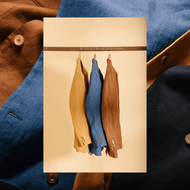ALL ABOUT LINEN
Posted by Bookster on 2nd May 2024
ALL ABOUT LINEN
It's that time of year. Still a nip in the air, but there have been a couple of days where temperatures rose and our yearning for sun and hot summer days come to mind. Linen is one of the natural fibres best suited for summer wear.
When you look into it as a fibre/fabric it has such an interesting history and catered for humble workers up to the ruling classes as luxury garments. It is believed to have originated in Egypt some 10,000 yrs ago but there is also some evidence that a prehistoric type of linen cloth may have existed 36,000 years ago. Linen fabric was introduced to Europe some 3000 years ago probably by the Phoenicians. (More on quality further on) It was the Middle Ages when linen production became a big thing in Europe. . Linen was produced in Ireland from the 11th Century and still maintains the mantle for its high quality
The source for linen production is Flax plant (Common Flax or Linseed. Linum Usitatissimium, Linaceae family) To think not only did you harvest Linseed seeds for consumption and Linseed oil you had a raw material for clothing too. It could grow in relatively poor soils and require far less water to be productive than by Cotton for instance.
Linen production is a very labour intensive process which means 2 things: It provides jobs…to add to other high production costs.

PRODUCTION OF LINEN
Linen is not produced as widely as cotton. Largely because of the difficult production processes and specialised care needed for the plants.
The linen threads are not flexible and so not easy to weave the linen . China is the largest manufacturer of linen, followed by Ireland, Italy, Belgium, and the USA.
In this article we will highlight our love of Irish Linen of which we offer a very special collection. But first consider what is involved in getting this fabric to our workroom….. The manufacturing process of linen is onerous:
1. CULTIVATION
Flax seeds need around 100 days to grow. The flax plant is a delicate and it cannot endure very hot weather. The soil must be prepared well and weeded often.
2. HARVESTING
The plants are ready for harvesting in around 90 days. When ready it has to be harvested immediately. Either manually or mechanically.

3. RETTING
After harvesting, the stalks are processed for the removal of leaves and seeds. Then the fibre is separated from the hard wooden interior part. This is the process of retting. It is a very critical process
4. BREAKING
After retting, the plants undergo a process called breaking. The stalks are moved through rollers to separate the ‘bast’ from the exterior fibres. Bast is from which linen is made.
5. COMBING
The process of combing or straightening of the fibres separates the short fibres from the long and fine linen fibres. The short fibres are used for making coarse and sturdy goods while the long fibres are used for spinning.
6. SPINNING
The long linen fibres, called Line fibres, go through the process of spinning, and a machines called spreaders are used. The fibres are laid parallelly, creating a sliver. These are again passed through rollers, after which the fibres are called ‘rovings’. These rovings are then ready to be spun on a spinning frame.
7. REELING
After spinning, the fibres are made into threads, which are then made into spools or bobbins. This process makes the fibres stronger and less elastic. Reeling needs to be carried out in wet and humid conditions and the linen fibres need to be run through a hot water bath to bind is closer together.
8. DRYING
The yarn finally goes through the process of drying. The yarn is then used for textile manufacturing for clothing use and other goods


Phew!!!
We are so proud to offer Linen cloths from, amongst others, Dugdale Bros of Huddersfield (Est 1896)
Lagan Valley Linen is a thoroughly modern collection steeped in time honoured routines of Irish linen production. Perfect for bespoke tailoring, it includes enhancements to suit the demands of modern day consumers.
The Lagan Valley extends from Belfast to Lisburn with the River Lagan at its heart. Historically a very powerful region for finest Irish Linen production.
Woven using traditional “dressed” linen threads and with a full calendared finish, the cloth appears initially quite rigid and harsh. A final and relatively new process of “dry washing” gently removes the sizing from the woven fibre by tumbling the finished piece of linen in an air jet washer.
Marvellously sustainable, using no water, this final process “antiques” the handle and imbues the linen with a soft and flowing appearance with better wear performance.
An amazing traditional cloth being produced in its original home but with excellent sustainability credentials and not least….wear longevity. We have added a selection of our favourites from the range on our site Click Here, if you see other colours you prefer from the Lagan Valley range just choose special cloth C and add to the notes - Dugdales full range of Linens can be found here https://www.dugdalebros.com/collections/

Another collection we adore is from Harrisons of Edinburgh which includes Linen Blends
https://www.harrisons1863.com/brand-portfolio/collection/harrisons-mersolair/ contact us if you are interested in any of these cloths.
We have even more choices and many options so do not hesitate to get in touch to discuss all the possibilities including for styling and fit advice. In a few weeks you could be wearing your unique garment....Contact Us
 British Pounds
British Pounds
 US Dollar
US Dollar


